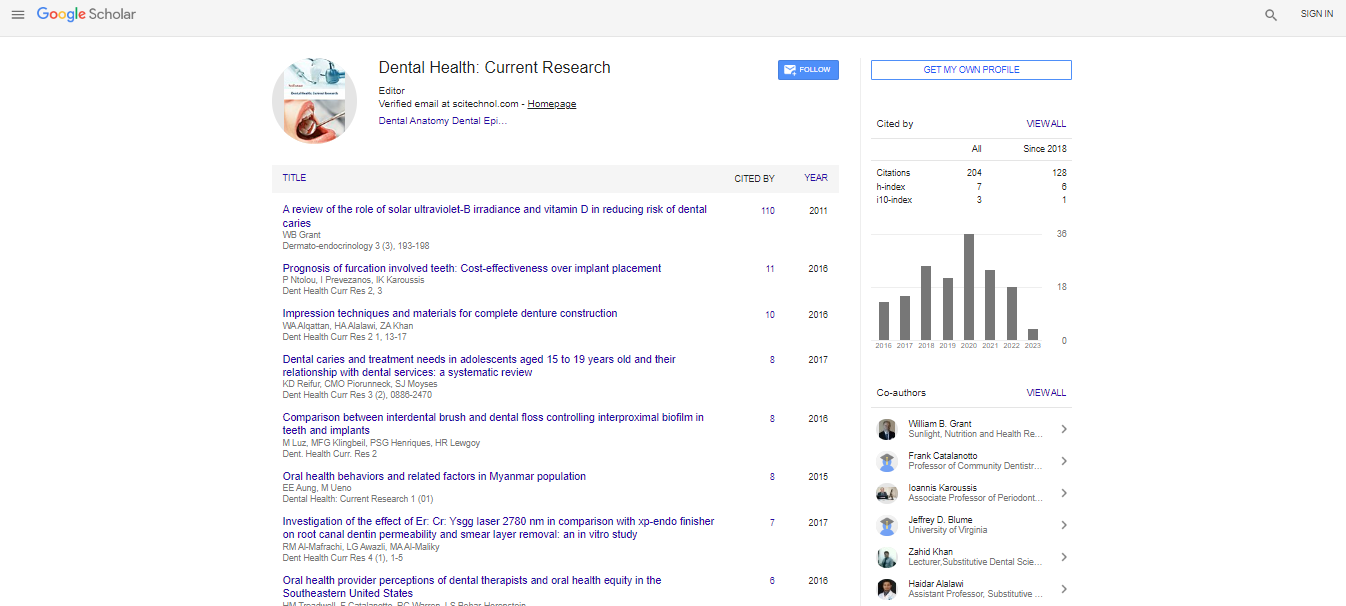The microbial analysis of survival strategies for opportunistic oral pathogens in the Oral Cavity
Gad Onywere
Northern Caribbean University, Jamaica
: Dent Health Curr Res
Abstract
Background: The diversity of microorganisms in the oral cavity plays a significant role in maintenance of good oral health [1, 2]. Bacteria forms an important group of microorganisms found in both healthy and diseased mouths. Commensal bacteria are regarded as beneficial by defending against the colonization of invading pathogens. The opportunistic pathogens are infectious pathogens that are normally commensal in the body but can cause diseases when the host’s resistance is alter [3, 4, and 5]. Aim: This study aimed at analysing microbial survival strategies of the opportunistic pathogens in the oral cavity. Methods: Six opportunistic bacterial pathogens were isolated from the oral cavity and sub-cultured in Blood and MacConkey agar. The isolates were: Streptococcus mutants, Staphylococcus aureus, Methicillin Resistant Staphylococcus aureus (MRSA), Klebsiella pneumonia, Enterococcus spp. and Pseudomonas aeruginosa. The biofilm formation and planktonic growth kinetics of these pathogens was screened to determine the attachment. Extracellular polymeric substance (EPS) of the microbes was then extracted using an organic solvent for microbial total chemical content analysis. Findings: Streptococcus mutants and Enterococcus spp. had the highest biofilm formation (0.06Au) while Pseudomonas aeruginosa had the lowest biofilm formation (0.004Au). Klebsiella pneumonia had the fastest planktonic growth rate (0.0014 cells/minute) and generation time (49.5 minutes); Pseudomonas aeruginosa had the slowest growth rate (0.010 cells/minute) and generation time (69.3 minutes). The EPS content for Streptococcus mutants was the highest followed by MRSA, Staphylococcus aureus and Enterococcus spp. Conclusions: Planktonic growth kinetics influences biofilm formation size and microbial population growth. Biofilm formation act as a defensive mechanism of the pathogens during various stress conditions. The EPS is the major component in establishing functional and structural integrity of the pathogens. Therefore, understanding the survival strategies of these microbes is significant in future prevention and treatment of oral infections. Acknowledgments: We thank the Department of Graduate Studies and Research, Department of Biology, Chemistry and Environment Science at the Northern Caribbean University for providing the facilities and resources utilized in the study.
Biography
Gad Onywere holds a Ph.D. degree in Biology and a Post Graduate Diploma in Education from Northern Caribbean University (NCU), Mandeville, Jamaica. He works as an Assistant Professor at the Department of Biology, Chemistry and Environmental Science at NCU. He enjoys teaching and doing research in the life sciences. His main research areas include but not limited to utilization of plant nutraceutical as antimicrobial in Oral health, control of microbial pathogens and molecular basis of microbial pathogenicity. Onywere has published research articles in International Journal of Healthcare Sciences, International Journal of Life Sciences and American Journal of Public Health. He has made several oral and poster presentations at the Ministry of Health and Wellness Annual Research Conference and Annual Dental Auxiliaries Conference. The details of the presentations can be found in the Ministry Bulletin 2015, 2016, 2017, 2018 and 2019. Onywere is happily married to Rose Andree Onywere.
 Spanish
Spanish  Chinese
Chinese  Russian
Russian  German
German  French
French  Japanese
Japanese  Portuguese
Portuguese  Hindi
Hindi 